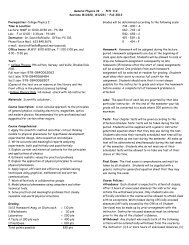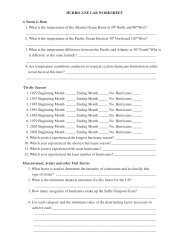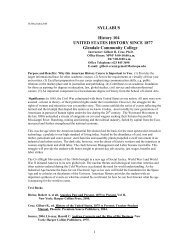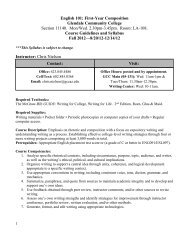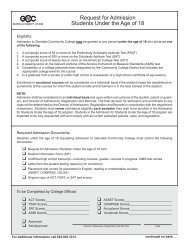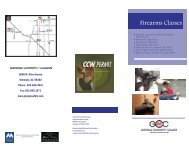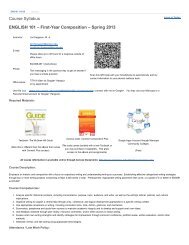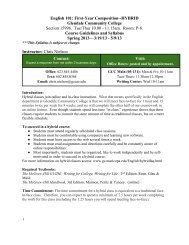Economics 111 section 1930: Macroeconomic Principles
Economics 111 section 1930: Macroeconomic Principles
Economics 111 section 1930: Macroeconomic Principles
Create successful ePaper yourself
Turn your PDF publications into a flip-book with our unique Google optimized e-Paper software.
<strong>Economics</strong> 211 <strong>section</strong> 15440: <strong>Macroeconomic</strong> <strong>Principles</strong> (Fall 2009)<br />
Monday, Wednesday, and Friday, 11-11:50am in room CL-15 at GCC<br />
Instructor: Aleksander “Sasha” Radisich<br />
Office: 05-108<br />
Office Hours: Monday through Friday, 9-10am<br />
Office Phone: (623) 845-4765<br />
Department: (623) 845-3685<br />
E-Mail: sasha.radisich@gcmail.maricopa.edu<br />
Textbook:<br />
Baumol and Blinder, <strong>Macroeconomic</strong>s (optional)<br />
Official Course Description: A descriptive analysis of the structure and functioning<br />
of the American economy. Emphasis on basic economic institutions and factors that<br />
determine national income and employment levels. Consideration given to the<br />
macroeconomic topics of national income, unemployment, inflation and monetary and<br />
fiscal policies. Prerequisites: None.<br />
Course Objectives: This course will introduce economic thought, theory, and<br />
analysis. Specifically, 211 addresses topics in macroeconomics: the study of the overall<br />
economy and how it works as a unit. Do not let the theoretical framework fool you: this<br />
course intends to provide you with solid tools for analyzing real-world problems that<br />
countries and economies face every day. The official course competencies can be found<br />
online at http://www.maricopa.edu/curriculum/D-L/072ecn211.html<br />
Attendance Policy: Attending class is mandatory for success. The material in this<br />
course is difficult to absorb and will often require guidance. Furthermore, future topics in<br />
this course build on past topics, so falling behind will often lead to an insurmountable<br />
deficit of knowledge. I will circulate an attendance sheet at the beginning of each class;<br />
failing to sign the sheet four times may result in my withdrawing you from the class. If<br />
you absolutely cannot attend class, be sure to come to my office hours to discover what<br />
you missed. Also, get a copy of the notes from someone else in the class so that you<br />
don’t fall as far behind.<br />
Quizzes: Every Friday (beginning on September 18 th ) during the first 15 minutes of the<br />
class we will have a quiz. While quizzes cannot be made up for any reason, I will drop<br />
your lowest quiz score. The quizzes will determine 10% of your final grade. These<br />
quizzes are designed as a learning experience, and you should use your results on them to<br />
help focus your studying where it will benefit you the most. All quizzes will be<br />
comprehensive, but will focus primarily on the most recent materials.<br />
Midterm: We will have a comprehensive midterm examination in class on Wednesday,<br />
October 28 th . This exam will be worth 40% of your final grade in this class.
Final: Our final examination will be on Wednesday, December 16 th , at 11am. It will<br />
determine 50% of your final grade in the class. The final will be a two-hour<br />
comprehensive examination of all materials from the entire semester.<br />
Grading: This class will be curved. In rough terms, the top 10% of students will earn<br />
an “A,” the next 20% will earn at least a “B,” the middle 40% will earn at least a “C,” the<br />
next 20% will earn at least a “D,” and the bottom 10% will earn an “F” in this course.<br />
Extra credit can only be earned on quizzes and tests. In the interest of fairness, I offer no<br />
outside extra credit to anybody.<br />
Course Outline:<br />
1. Introduction to <strong>Economics</strong><br />
a. Chapter 1 – What Is <strong>Economics</strong>?<br />
b. Chapter 2 – The Economy: Myth and Reality<br />
c. Chapter 3 – The Fundamental Economic Problem: Scarcity and Choice<br />
d. Chapter 4 – Supply and Demand: An Initial Look<br />
2. Aggregating Supply and Demand<br />
a. Chapter 5 – An Introduction to <strong>Macroeconomic</strong>s<br />
b. Chapter 6 – The Goals of <strong>Macroeconomic</strong> Policy<br />
c. Chapter 8 – Aggregate Demand and the Powerful Consumer<br />
d. Chapter 9 – Demand-Side Equilibrium: Unemployment or Inflation?<br />
e. Chapter 10 – Supply-Side Equilibrium: Unemployment and Inflation?<br />
3. The Economic Role of the Government<br />
a. Chapter 11 – Managing Aggregate Demand: Fiscal Policy<br />
b. Chapter 13 – Managing Aggregate Demand: Monetary Policy<br />
c. Chapter 14 – The Debate Over Monetary and Fiscal Policy<br />
d. Chapter 15 – Budget Deficits in the Short and Long Run<br />
e. Chapter 16 – The Trade-Off Between Inflation and Unemployment<br />
Audio Taping: I allow the audio taping of my classes at any time.<br />
Discipline: Disciplinary standards in this course will be maintained as per the current<br />
GCC student handbook.<br />
Disability Statement: The college will make reasonable accommodations for people<br />
with documented disabilities. Students should notify the Disabled Student Resources<br />
Office and their instructor of any special needs.<br />
Disclaimer: Course content may vary from this outline to meet the needs of this<br />
particular group.






